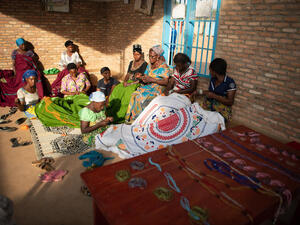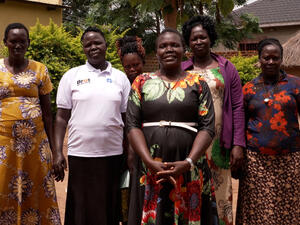Return figures to Afghanistan down to 60,000 in first 10 months
Return figures to Afghanistan down to 60,000 in first 10 months

A returnee family gather next to their vegetable patch in eastern Afghanistan's Nangarhar province, one of the main areas of return from Pakistan.
KABUL, Afghanistan, October 28 (UNHCR) - The number of Afghan refugees returning home with UNHCR help has dropped substantially this year, with some 60,000 repatriating from neighbouring countries in the first 10 months compared to more than 100,000 over the same period in 2010.
The returnees included 43,000 from Pakistan, about 17,000 from Iran and less than 100 from other countries. The return figure for Pakistan was 59 per cent lower than last year, but returns from Iran rose from 7,500 a year earlier.
The lack of livelihood opportunities and shelter, as well as insecurity, are the most frequently cited reasons for not returning. Most Afghan refugees in Pakistan live in Khyber Pakhtunkhwa and Balochistan provinces and originate from insecure, undeveloped areas of Afghanistan.
Pakistan is currently home to 1.7 million Afghan refugees, many of whom who have lived in exile for more than a quarter of a century. Half these people were born outside Afghanistan and do not own property there.
The reason for the increase in voluntary assisted returns from Iran appears to be due to economic pressures and the discontinuation of subsidies on basic goods and services by the Iranian government.
To date, the main provinces of return in Afghanistan were Kabul (26 per cent), Nangarhar in the east (14 per cent), the western province of Herat (8 per cent) and Kunduz in the north (8 per cent).
Since March 2002, UNHCR and its government counterparts have assisted 4.6 million Afghans to return home, mainly from Pakistan and Iran. Most have headed back to four main provinces: Kabul (26 per cent); Nangarhar (20 per cent), Kunduz (6 per cent) and Baghlan (5 per cent). In total, 5.7 million Afghan refugees have returned alone or with assistance from Pakistan and Iran, representing nearly a quarter of Afghanistan's population.
Despite security problems in parts of the country and economic needs, Afghan refugees are still returning in significant numbers. The government and its partners are working to ensure sustainable reintegration.
But initial findings of a survey launched recently by UNHCR and Afghanistan's Ministry of Refugees and Repatriation indicate that around 40 per cent of the returned Afghans have not yet fully reintegrated into their original communities.
Afghanistan's capacity to absorb additional returns is limited. Some families who returned this year will need additional support to make it through the winter. Many others don't have land, shelter, schools and health care. These families need job opportunities to become self-sufficient.
Nearly 3 million registered Afghan refugees remain in exile in the region today, including the 1.7 million in Pakistan and 1 million in Iran. UNHCR is calling for international support to help returnees settle back in their homeland.
The refugee agency, with the governments of Afghanistan, Pakistan and Iran, is developing a multi-year (2012-2014) solutions strategy for Afghan refugees. This will be presented for endorsement by the international community at a conference in early 2012.
By Mohammad Nader Farhad in Kabul, Afghanistan








